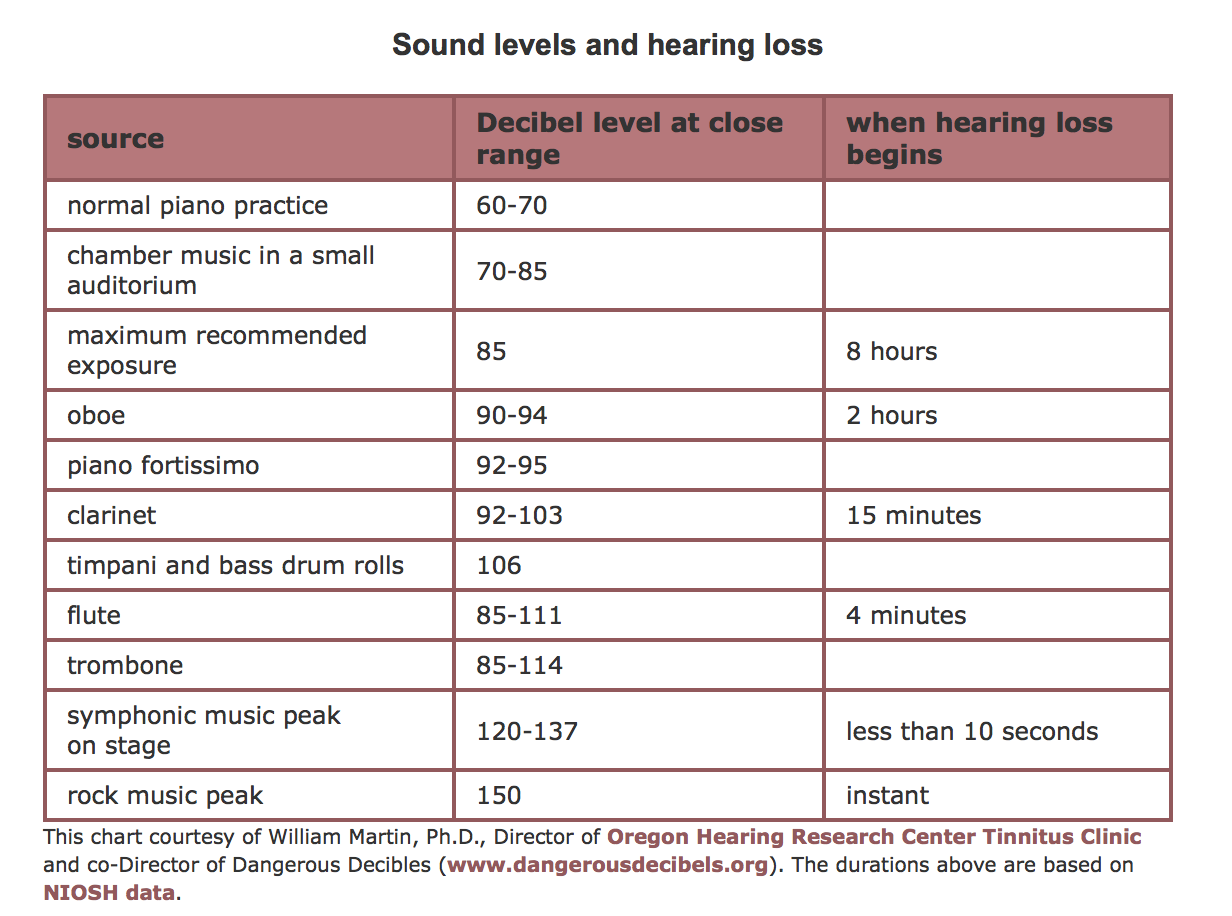Every career tends to have its own form of occupational hazards. For musicians, the damage to our bodies can often sneak up on us over time and it isn’t silent. A research study published in 2013 stresses the prevalence of noise-induced hearing loss in horn players. While we are often aware of the dangers of hearing loss, many don’t take the necessary precautions to protect our hearing. This post will provide a brief overview of noise-induced hearing loss, why musicians often don’t protect their hearing, and what you can do to prevent hearing damage.
Noise-Induced Hearing Loss
Noise-Induced Hearing Loss (NIHL) has been described by the National Institute on Deafness and Other Communication Disorders (NIDCD) to occur when the inner structures of the ear are damaged when hearing loud noises. This can occur immediately, or over time and it can affect one or both ears. Sound is measured in decibels and sounds that are heard for a prolonged amount of time above 85 decibels can cause hearing loss. Of course, the higher the decibel level, the faster the sound will cause damage. Here is a chart from the NIDCD website that shows the decibel readings of familiar sounds. Also, here is a link to the NIDCD website, which provides additional information about noise-induced hearing loss.

If you are curious, here is a chart that shows the decibel levels that are experienced by musicians on a daily basis.

Noise-Induced Hearing Loss in Horn Players
In 2010, researchers from the University of Queensland attended the annual International Horn Symposium in Brisbane, Australia to study how NIHL affects horn players. This study resulted in the article “The Audiological Health of Horn Players,” which was written by Wayne J. Wilson, Ian O’Brien, and Andrew P. Bradley and published in the 2013 Journal of Occupational and Environmental Hygiene. This study included 142 horn players and the results showed a staggering 11.1% to 22.2% of horn players in the study experienced NIHL with 17.7% to 32.9% of participants who were forty or older experiencing NIHL. It is also surprising that this study discovered that only 18% of the 142 participants use hearing protection! For more details on this study, check out this summarized article published in Science Daily.
Why Do Horn Players Avoid Hearing Protection?
While it may seem obvious that we would want to protect one of our greatest assets, the study completed in Brisbane clearly shows that we aren’t as invested in our hearing protection as you would hope. Mead C Killion, a researcher at Northwestern University, discusses many of the reasons why we avoid using hearing protection in the article “Factors Influencing Use of Hearing Protection by Trumpet Players,” which was published in the December 2012 issue of Trends in Hearing.
Here is a list of three reasons why brass players might not wear hearing protection:
- Insufficient Acclimatization- It can take around two weeks to acclimate to the change of timbre that is experienced when wearing hearing protection.
- Absence of “Fortissimo Blare” from Aural Distortion
- Poor Seal from the Ear Plugs- This can cause a hollow sound like you are playing into a barrel or can cause an un-even decibel reduction for certain frequencies.
How Can You Protect Your Hearing?
- Custom Earplugs- Custom Earplugs can be made by an audiologist to fit perfectly for your ear. They cause an even reduction of varying decibel levels through all registers. If you are a student or faculty member at a university, these earplugs can frequently be purchased through your university for a reduced cost.
- Etymotic Hearing Protection– This company provides both custom and non-custom hearing protection options. They have a large variety of non-custom products that allow you to choose the hearing protection that best meets your needs and it is also much more cost effective!
- Placement in Ensembles- If you have flexibility in where you are seated in the ensemble, it is wise to not be seated directly in front of the trumpets, trombones, or percussion. Also, ensure that there is adequate space between you and your fellow horn players. If you do not have this flexibility, it is helpful to use sound shields to block excessive volume.
- Decibel Meter– Track the volume of your rehearsal and practice spaces to see if you might be at risk for NIHL. Decibel meters can be downloaded onto your phone and can be used as an indicator for when to use hearing protection. Some apps that can be used include Decibel X, SPLnFFT Noise Meter, NOISH Sound Level Meter, and SPL Meter.
Now that you know a little more about the occupational hazards of our career, you can take the necessary precautions to create a safe work environment for yourself!
Additional Reading
Iltis, Peter W. “Medical and Scientific Issues: Hearing Protection.” The Horn Call XL, no. 1 (October 2009): 39-41.
Pouryaghoub, Gholamreza, Ramin Mehrdad, and Saeed Pourhosein. “Noise-Induced Hearing Loss Among Professional Musicians.” Journal of Occupational Health 59, no. 1 (2017): 33-37.
Rodrigues, MA, MA Freitas, MP Neves, and MV Silva. “Evaluation of the Noise Exposure of Symphonic Orchestra Musicians.” Noise & Health 16, no. 68 (2014): 40-46.
Royster, JD, LH Royster, and MC Killion. “Sound Exposures and Hearing Thresholds of Symphony-Orchestra Musicians.” Journal of the Acoustical Society of America 89, no. 6 (1991): 2793-2803.
Thakurdas, Amy. “Hearing Conservation and Noise-Induced Hearing Loss.” The Horn Call XLIX, no. 2 (February 2019): 33-35.
Resources
Killion, Mead C. “Factors Influencing Use of Hearing Protection by Trumpet Players.” Trends in Amplification 16, no. 3 (September 2012): 173–78.
National Institute on Deafness and Other Communication Disorders (U.S.). Noise-Induced Hearing Loss. Update March 2014. ed. Vol. no. 14-4233. Bethesda, Maryland: U.S. Department of Health and Human Services, National Institutes of Health, National Institute on Deafness and Other Communication Disorders, 2014.
Wilson, Wayne J., Ian O’Brien, and Andrew P. Bradley. “The Audiological Health of Horn Players.” Journal of Occupational and Environmental Hygiene 10, no. 11 (2013): 590-96.